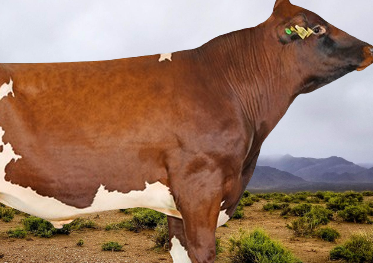Norwegian Red is a dairy cattle breed that was established in Norway in 1935. This dual-purpose breed, which combines dairy and beef, has been chosen with a broad breeding goal in mind, with a growing focus on functional attributes like fertility and health.

Norwegian Red cows have a high percentage of animals that are genetically polled and can have a coat that is either red and white or black. At maturity, their average weight is approximately 1,342 lbs (610 kg), making them medium-sized cows. Although the majority of them are red or red-pied, Norwegian Red cattle lack the external uniformity observed in genuine breeds.
Advantages
High Fertility
The remarkable fertility of Norwegian Red cattle is one of its most notable qualities. These cattle have the ability to breed naturally, which facilitates effective cycles of reproduction. This helps to maintain the herd's overall sustainability while also making breeding easier for producers.
High Milk Production
Norwegian Red cattle go above and beyond the typical dairy business goal of producing large amounts of milk by prioritizing milk quality over quantity.
High Fat and Protein Milk
Nowadays, consumers are more picky about the nutrients in the food they consume. With its high protein and fat content, Norwegian Red milk suits these preferences. This not only satisfies consumer demand but gives dairy farmers new opportunities.
Mastitis Resistance
Norwegian Red cattle successfully handle mastitis, a common problem in the dairy industry. Their innate ability to fend against mastitis plays a major role in preserving udder health. Consequently, this lowers the requirement for antibiotics and the associated expenses for farmers.
Calving Ease
The calving season may be a stressful period for both farmers and cattle. Due to their ease of calving, Norwegian Red cattle give birth with less assistance. This helps to improve the overall effectiveness of farm management while also reducing the workload for farmers.
Longevity
Dairy producers benefit from the longevity of Norwegian Red cattle. These cattle continue to contribute to milk production for a lengthy period of time, which benefits the economy due to their long productive lifespan.
Disadvantages
Cost
Farmers must take into account the initial outlay of funds necessary to purchase and establish Norwegian Red Cattle, despite the enormous economic benefits. This consists of investing in essential instruments, procuring suitable housing for the cattle, and purchasing them.
Limited popularity
A population of approximately 28,000 in Norway does not place the breed among the most renowned internationally or in terms of exports.
Crossbreeding challenges
Norwegian Red crossbreeding can be more difficult because of their distinctive traits, which don't necessarily go well with other breeds.









0 Comments